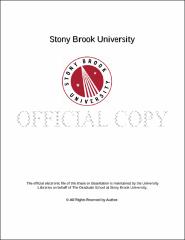| dc.identifier.uri | http://hdl.handle.net/11401/77753 | |
| dc.description.sponsorship | This work is sponsored by the Stony Brook University Graduate School in compliance with the requirements for completion of degree. | en_US |
| dc.format | Monograph | |
| dc.format.medium | Electronic Resource | en_US |
| dc.language.iso | en_US | |
| dc.publisher | The Graduate School, Stony Brook University: Stony Brook, NY. | |
| dc.type | Dissertation | |
| dcterms.abstract | Pelagophytes are important picoplankton in the open ocean and in coastal waters where Aureococcus anophagefferens and Aureoumbra lagunensis form ecosystem-disruptive brown tides. Despite decades of research, factors facilitating brown tides are not completely understood. This dissertation is a comparative study of pelagophytes assessing processes facilitating brown tides and transcriptional similarities among open ocean and coastal pelagophytes. During my dissertation, top-down (e.g. grazing) and bottom-up (e.g. nutrients) processes shaping phytoplankton communities were examined during brown tides in the Indian River Lagoon, Florida, USA. While moderate levels of ammonium promoted Aureoumbra growth over picoprokaryotes, grazing pressure on Aureoumbra was near absent permitting this alga to outgrow co-existing phytoplankton. My research also discovered that Aureoumbra forms resting cells in response to environmental stressors such as high temperature, nutrient limitation, and darkness. Resting cells were characterized by larger biovolumes compared to vegetative cells, development of red accumulation bodies, and enriched sterol content. In addition, resting cells could revert to vegetative cells after seven months of dark storage, an observation consistent with field observations showing re-occurrence of brown tides in Indian River Lagoon six months after an initial bloom. This dissertation also discovered the strong allelopathic effects of Aureococcus and Aureoumbra on co-occurring algae. Allelopathic effects were broad, causing significant dose-dependent inhibition in the growth of multiple phytoplankton species at brown tide densities of >2.5 x 105 cells mL-1 suggesting allelopathy may be important for the intensification and persistence of blooms. Sorting flow cytometry was combined with species-specific immune-detection of Aureococcus to contrast the nutritional ecology of the brown tide alga with other co-occurring picoplankton during blooms and provided a comparison of nitrogen uptake on a per-cell basis that affirmed the importance of urea in promoting Aureococcus blooms. Lastly, comparative transcriptomics of four pelagophytes demonstrated that these algae commonly express functional genes associated with cleavage of organic nitrogen under low N conditions, the utilization of intracellularly recycled phosphate under low P conditions, and the use of flavodoxins over ferredoxins under low light conditions. Collectively, this research provides a new understanding of the mechanisms facilitating brown tides and transcriptional similarities among pelagophytes. | |
| dcterms.available | 2017-09-20T16:53:30Z | |
| dcterms.contributor | Taylor, Gordon T | en_US |
| dcterms.contributor | Gobler, Christopher J | en_US |
| dcterms.contributor | Collier, Jackie L | en_US |
| dcterms.contributor | Baines, Stephen B | en_US |
| dcterms.contributor | Kudela, Raphael M. | en_US |
| dcterms.creator | Kang, Yoonja | |
| dcterms.dateAccepted | 2017-09-20T16:53:30Z | |
| dcterms.dateSubmitted | 2017-09-20T16:53:30Z | |
| dcterms.description | Department of Marine and Atmospheric Science | en_US |
| dcterms.extent | 281 pg. | en_US |
| dcterms.format | Application/PDF | en_US |
| dcterms.format | Monograph | |
| dcterms.identifier | http://hdl.handle.net/11401/77753 | |
| dcterms.issued | 2016-12-01 | |
| dcterms.language | en_US | |
| dcterms.provenance | Made available in DSpace on 2017-09-20T16:53:30Z (GMT). No. of bitstreams: 1
Kang_grad.sunysb_0771E_13107.pdf: 5829757 bytes, checksum: 38d141dce831b752c4671ff71ad8cfba (MD5)
Previous issue date: 1 | en |
| dcterms.publisher | The Graduate School, Stony Brook University: Stony Brook, NY. | |
| dcterms.subject | Biological oceanography -- Ecology -- Physiology | |
| dcterms.subject | Brown tide, Ecology, Harmful Algal Bloom, Pelagophyte | |
| dcterms.title | An investigation of pelagophyte ecology | |
| dcterms.type | Dissertation | |

